Key Points
- Out of 15 snake species found in the state of Oregon, only two are venomous.
- Venomous snakes in Oregon include the western rattlesnake and the Northern Pacific rattlesnake.
- Western and central Oregon are home to the Northern Pacific Rattlesnake, while the western rattlesnake tends to inhabit the eastern half of the state.
Oregon is known for its amazing sights and wildlife populations. Animals living in this Northwest state include many species of mammals, birds, and yes, snakes. There are at least 15 different species of snakes living in Oregon, but only 2 are considered dangerous: the western rattlesnake and the Northern Pacific rattlesnake.
If you come across a snake in Oregon, you can tell it’s a rattlesnake if it has a triangular-shaped head, thin vertical pupils, and of course, a rattle at the end of its tail. Although rattlesnakes are venomous, they are non-aggressive and do not attack unless provoked. These snakes are essential to the ecosystems in Oregon, as they help to keep rodent populations in check. Let’s look at Oregon’s 2 resident rattlesnakes.
1. Western Rattlesnake
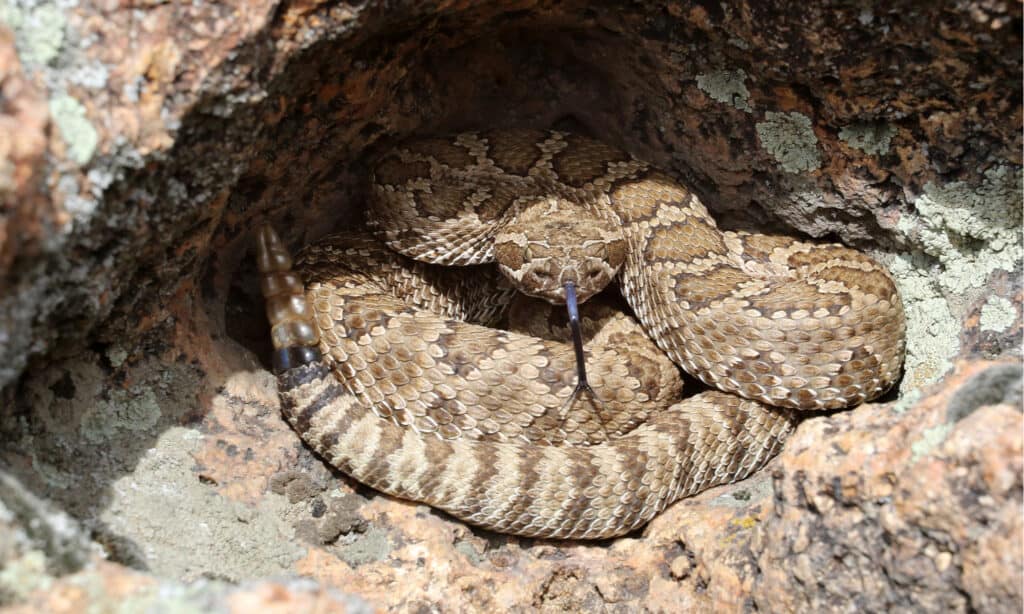
Often leading to confusion, the Western Rattlesnakes and the gopher snake are very similar in appearance.
©Randy Bjorklund/Shutterstock.com
| Western Rattlesnake | |
|---|---|
| Range | Eastern half of Oregon |
| Length | 16-64 inches |
The western rattlesnake lives in the eastern half of Oregon. These snakes are 16-64 inches long with thickset bodies and rough, keeled scales. They are gray, tan, or yellow-brown, with darker splotches down the middle of their backs. Great Basin rattlesnakes are generally solitary and shy. However, like most rattlesnakes they will defend themselves if they feel threatened.
The gopher snake — a harmless, nonvenomous snake species — is often mistaken for the western rattlesnake, due to their very similar appearance. However, the Great Basin rattlesnake has a large, triangular-shaped head, and a much thicker body than the Great Basin gopher snake.
2. Northern Pacific Rattlesnake
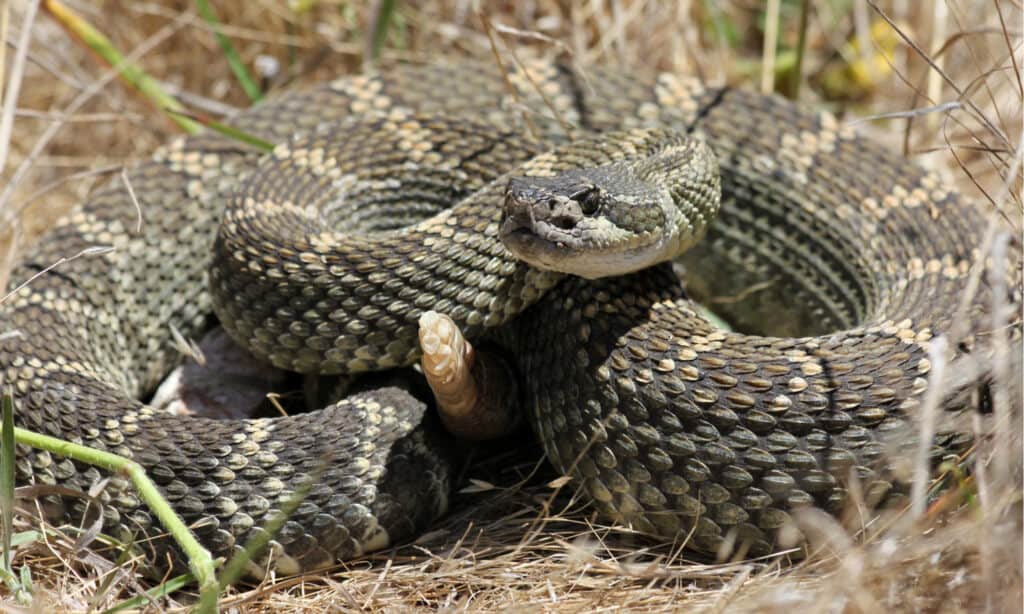
The longest Northern Pacific Rattlesnake on record was 64 inches long.
©Ryan M. Bolton/Shutterstock.com
| Northern Pacific Rattlesnake | |
|---|---|
| Range | Western & Central Northeastern Oregon |
| Length | 39 inches |
The Northern Pacific Rattlesnake lives in western and central northeastern Oregon. On average these snakes grow up to 39 inches long and are brown, gray, or greenish-brown. Patterned along their backs are large, square-shaped blotches. Younger snakes have lighter colors and more distinct patterns that get darker and less clear as they age.
Northern Pacific rattlesnakes are passive and rarely aggressive. These snakes may sun themselves on rocks during the day, but most of the time will stay hidden in rocky crevices. Their venom is a hemotoxic-neurotoxic mix that is quite potent.
Other Snakes In Oregon
In addition to the western and the Northern Pacific rattlesnake, there are at least 13 other kinds of non-venomous snakes that live in Oregon. Take a look at just a few of Oregon’s other snake species.
Gopher Snake
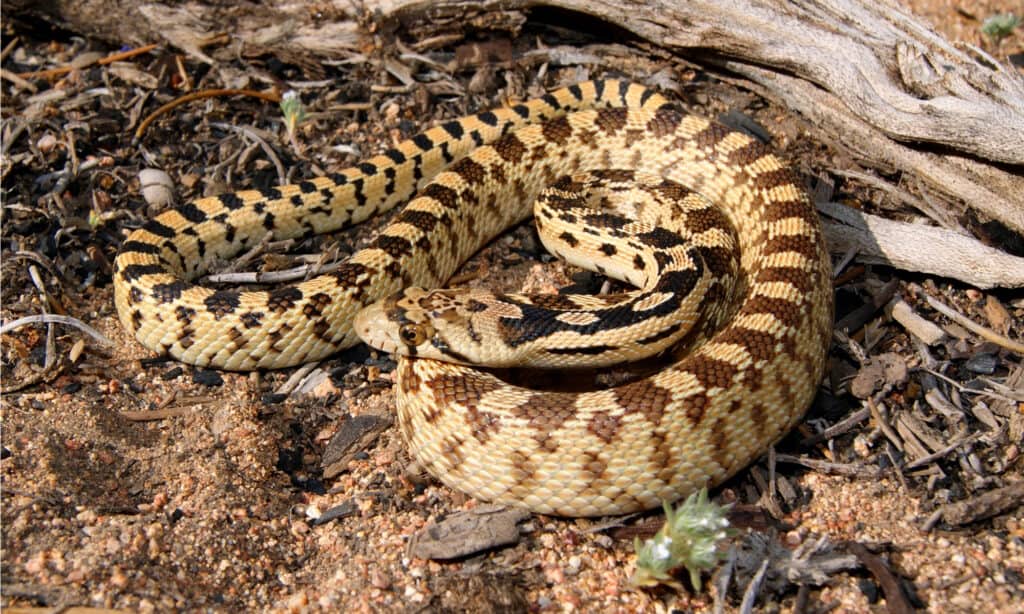
The Great Basin Gopher Snake often mimics a rattlesnake when it feels threatened.
©Matt Jeppson/Shutterstock.com
| Gopher Snake | |
|---|---|
| Range | Eastern half of Oregon |
| Length | 30-72 inches |
The Gopher Snake lives in the eastern half of Oregon and is usually 30-72 inches long. As mentioned before, this snake looks very similar to a rattlesnake, and it even twitches its tail like a rattlesnake. The gopher snake is yellowish, tan, or light brown in color, with dark square-shaped blotches running down its back. Its head is much smaller than that of a rattlesnake, however, and of course, it does not have a rattle at the end of its tail. Gopher snakes are excellent pest controllers for farmers, because they eat small mammals like rabbits and rodents. They also eat birds and lizards from time to time.
Northern Rubber Boa
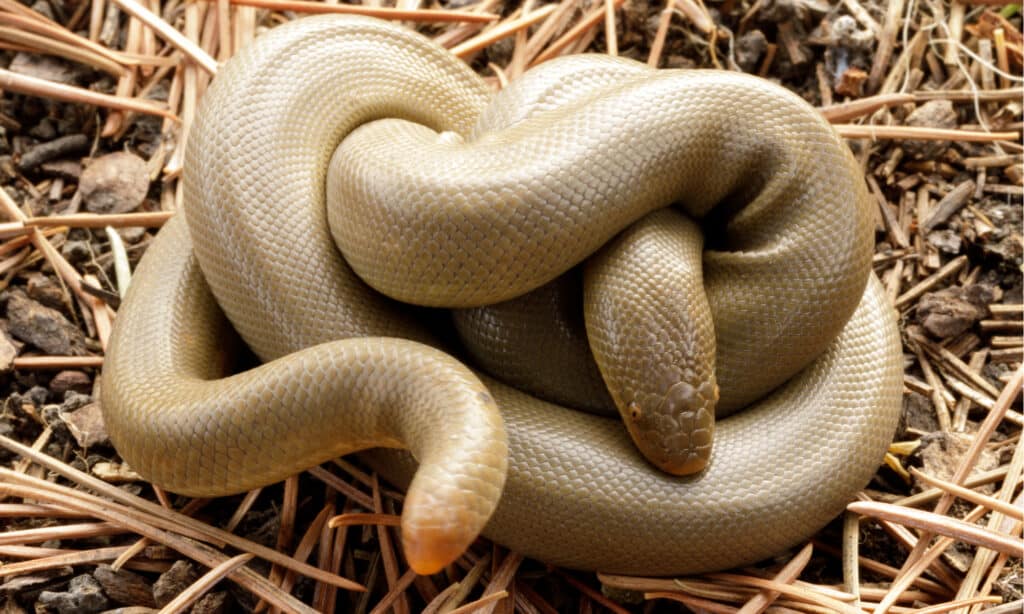
Rubber Boas are very docile snakes.
©yhelfman/Shutterstock.com
| Northern Rubber Boa | |
|---|---|
| Range | All of Oregon |
| Length | 14-33 inches |
The Northern Rubber Boa is 14-33 inches long and lives all throughout Oregon. Like its name, this snake is a light tan color and looks like rubber. The end of its tail is rounded and blunt, making it look almost like a second head–which is why this snake has nicknames like the “double-ender” and the “two-headed snake.” The rubber boa uses its tail as a decoy when it feels threatened, striking with it while hiding its real head.
Garter Snake
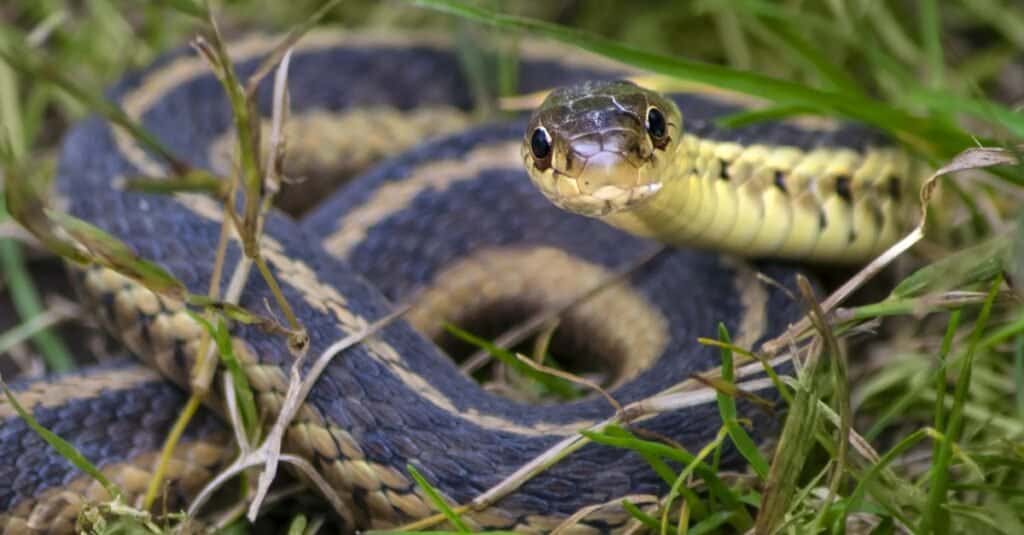
Garter snakes don’t have fangs and aren’t venomous. However, they do have a few rows of small teeth and can bite.
©K Quinn Ferris/Shutterstock.com
| Garter Snakes | |
|---|---|
| Range | All of Oregon |
| Length | 18-54 inches |
Garter Snakes are one of the most common types of snakes living in Oregon. There are several different types of garter snakes found in Oregon, like the common garter snake, Pacific Coast aquatic garter snake, northwestern garter snake, and western terrestrial garter snake. Like its name, the “common” garter snake is the most common snake found in Oregon. The common garter snake is longer than the other types, growing up to 54 inches long. This snake comes in many different colors, but usually has a distinctive stripe running down the middle of its back. Garter snakes are harmless and often are welcome guests in gardens because they eat pests like spiders, slugs, insects, and leeches.
Western Yellow-Bellied Racer
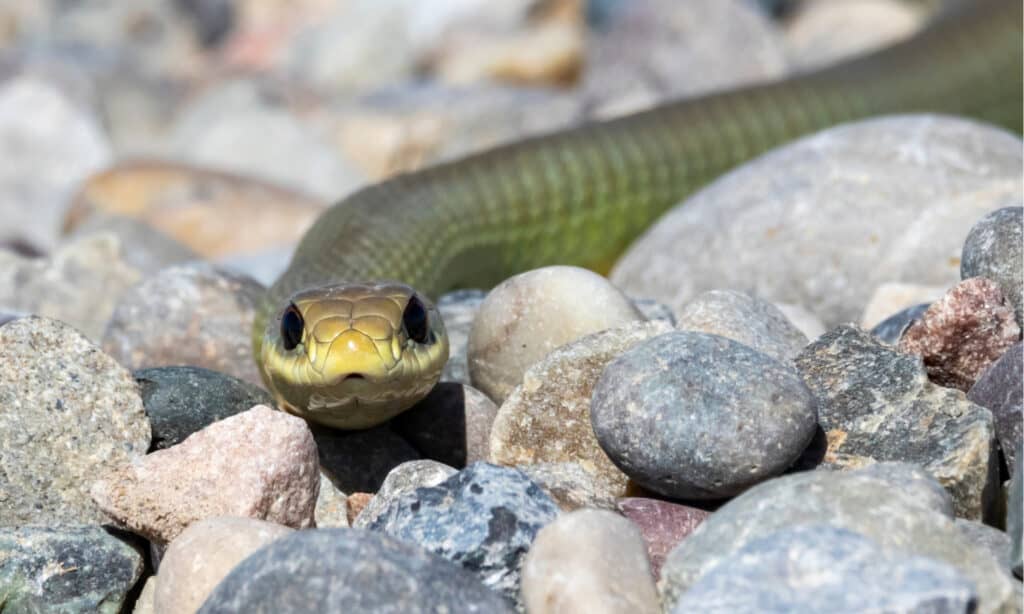
Racer snakes are identifiable by their long, thin bodies with darker-colored backs and light-colored bellies.
©Michael Chatt/Shutterstock.com
| Racer | |
|---|---|
| Range | Eastern half of Oregon |
| Length | 36-72 inches |
The Western Yellow-Bellied Racer is a subspecies of racer snake that lives mostly in the eastern half of Oregon, although it is rarely seen in high mountains or dry areas. These snakes prefer sunny, dry areas, although they can also be found in marshes and along the edges of lakes. The western yellow-bellied racer is a non-venomous snake with a long and slender body, usually measuring between 36-72 inches.
California Mountain Kingsnake
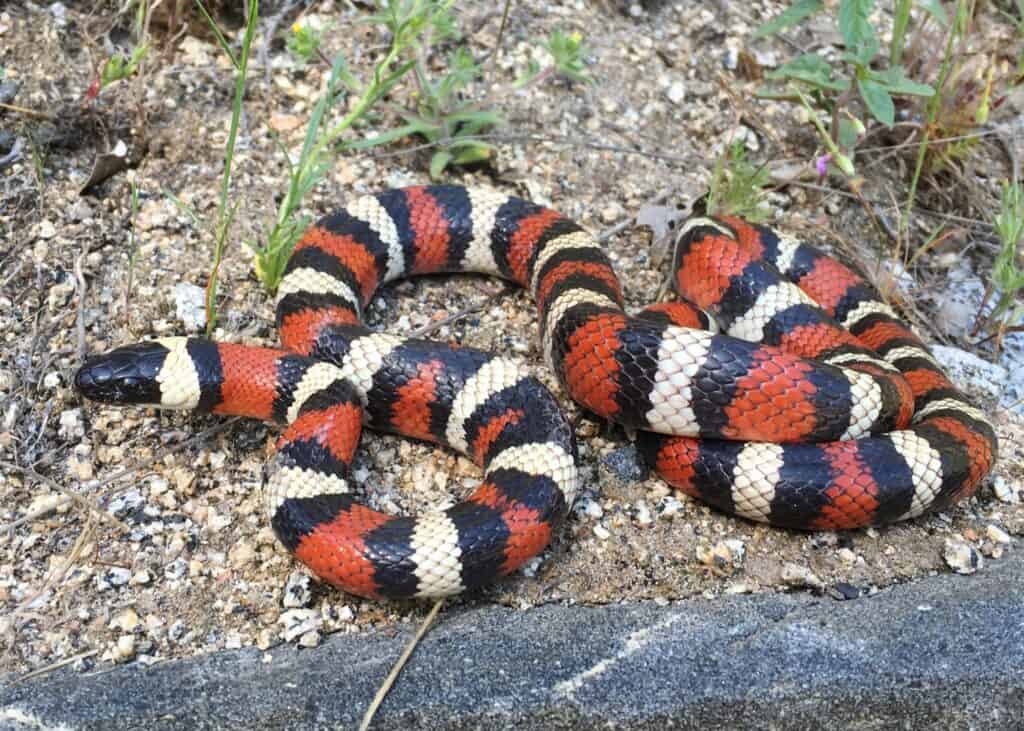
California mountain kingsnakes are often mistaken for venomous coral snakes due to their bold colors
©Matt Jeppson/Shutterstock.com
| California Mountain Kingsnake | |
|---|---|
| Range | Southwestern Oregon |
| Length | 20-40 inches |
The California Mountain Kingsnake lives in woodland habitats and rocky outcrops in southwestern Oregon. These snakes are 20-40 inches long with red, black, and white bands all along the length of their bodies. These vibrant colors and stark patterns are part of the California mountain kingsnake’s defensive system. Its appearance mimics other dangerous snakes, helping to keep predators away. However, in reality, these snakes are actually nonvenomous and harmless! The California mountain kingsnake is an Oregon Conservation Strategy Species.
Striped Whipsnake
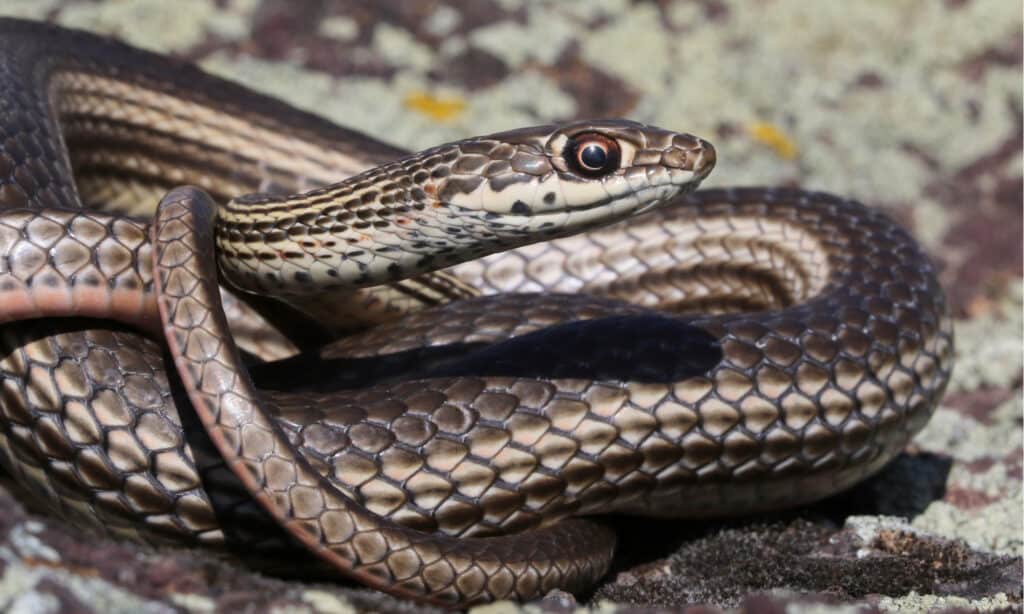
The Desert Striped Whipsnake lives in the western United States and northern Mexico.
©Randy Bjorklund/Shutterstock.com
| Striped Whipsnake | |
|---|---|
| Range | Northwestern Oregon |
| Length | 24-72 inches |
The Striped Whipsnake is commonly found in northwestern Oregon. This snake is known for its ability to move really fast, similar to a whip. It has a long body with two long stripes running down the sides. Striped whipsnakes eat small mammals, birds, lizards, and smaller snakes. Some are even known to eat small rattlesnakes.
Summary: Venomous Snakes In Oregon
| Species | Habitat |
|---|---|
| Great Basin rattlesnake | Eastern Oregon |
| Northern Pacific Rattlesnake | Western & Central Oregon |
Other Dangerous Animals Found In Oregon
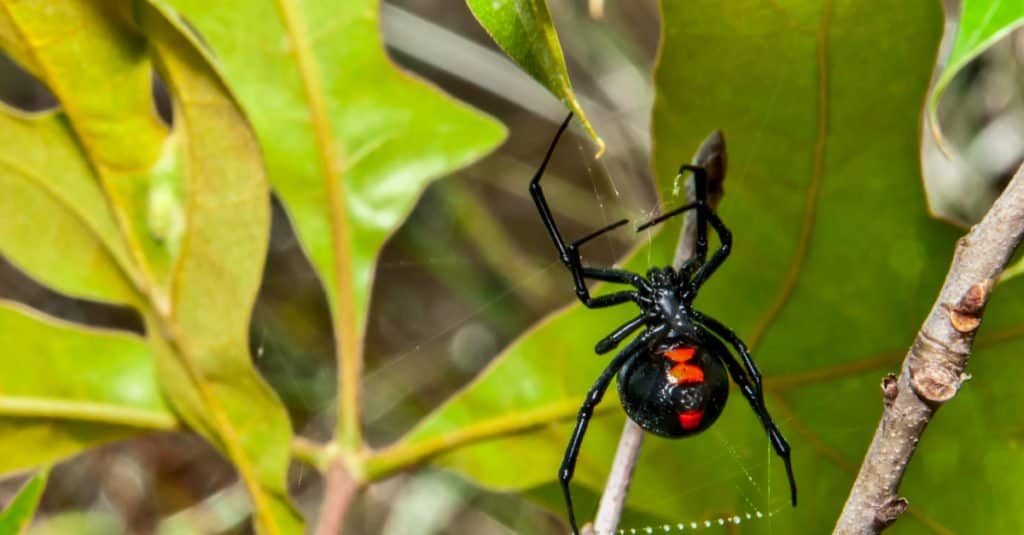
Despite its tiny stature, the black widow spider possesses a significant amount of venom. Its bite releases a neurotoxin called latrotoxin, which can cause extreme pain, muscle rigidity, vomiting, and heavy sweating.
©Jay Ondreicka/Shutterstock.com
Oregon has at least 500 species of spiders but only one is listed as the most dangerous spider – the black widow spider. It is even scarier than most in this state because it will frequently enter homes. One of only three venomous spiders found in the United States, this arachnid’s bite can not only cause severe pain but will cause a variety of other symptoms as well, some of which include nausea, cramping, and sweating. As the most venomous spider in North America, its venom is 15 times stronger than rattlesnake venom but since they are so small, not much venom is released at once so its bite is only a high risk for very young children and the elderly, however, all who are bitten should seek medical attention immediately.
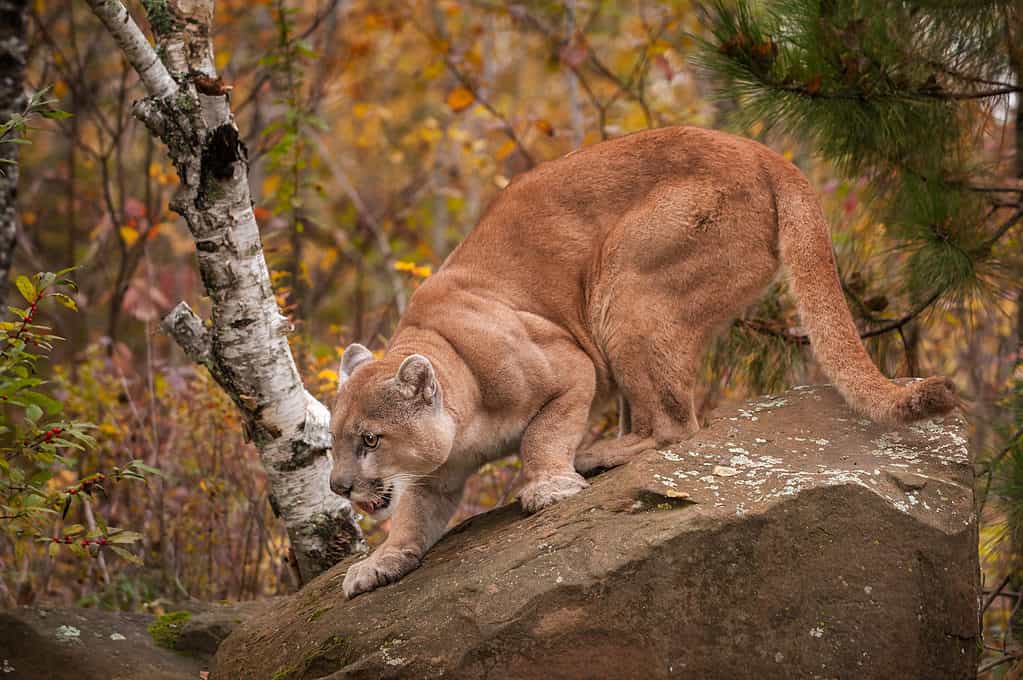
The
mountain lion
also referred to as a cougar, can be found statewide.
©Holly Kuchera/Shutterstock.com
Commonly found in the northeastern and southwestern parts of the state, in the Blue Mountains and Cascade Mountain Range respectively, the cougar was once a rare sighting but is now becoming more prevalent, especially in more suburban areas. These cats are native to Oregon and are very territorial, with a home range of up to 100 miles. They prefer to hunt alone and their preferred meals are deer but will also dine on bighorn sheep, elk, raccoons, and other mammals they may find. Cougars can reach weights of up to 220 pounds and if you encounter one you should not run as this triggers their chase response.
The photo featured at the top of this post is ©
Discover the "Monster" Snake 5X Bigger than an Anaconda
Every day A-Z Animals sends out some of the most incredible facts in the world from our free newsletter. Want to discover the 10 most beautiful snakes in the world, a "snake island" where you're never more than 3 feet from danger, or a "monster" snake 5X larger than an anaconda? Then sign up right now and you'll start receiving our daily newsletter absolutely free.
Thank you for reading! Have some feedback for us? Contact the AZ Animals editorial team.






